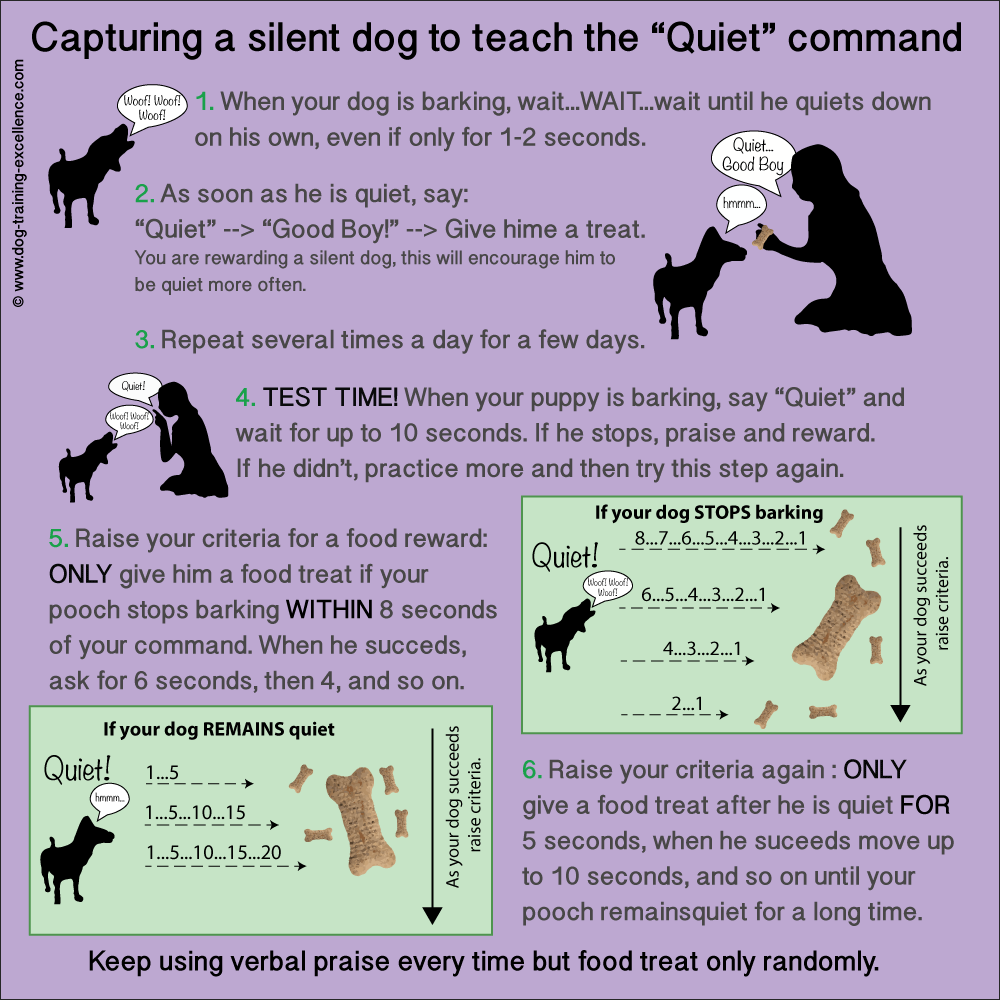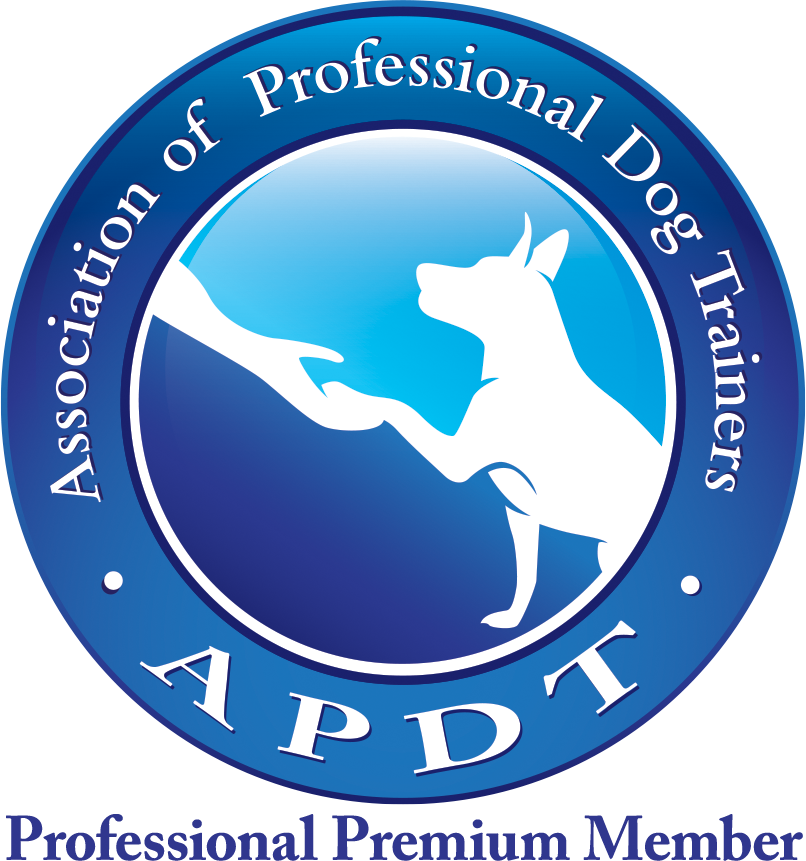I try to write my posts as unbiased as possible and recommend the products I consider to be useful and the best. I use affiliate links, this means that–at no extra cost to you–I can make a commission on a purchase you make after clicking on them. As an Amazon Associate I earn from qualifying purchases.
How to stop dog barking?
Teach your dog the "Quiet" command.
How to stop dog barking? There are many methods and techniques. In this section I want to teach you how to train the "quiet" command to your dog so you can gently ask him to stop being so loud.
This useful command, can tell your pet to quiet down when he is barking incessantly. I highly recommend you train this to your pet from puppy-hood (see also the "settle" command to calm a hyper dog or puppy).
If after teaching the Quiet command your pet still has barking problems, please visit our main page on barking for more solutions, tips and advice.
To learn how to stop dog barking, we are going to use a dog training method called "capturing". It is very easy and efficient if done properly. The idea is to wait until your pet does the behavior you want (on his own), so you can instantly reward him for it. With many repetitions the animal learns that doing the behavior pays! Now you can add a command to it and work on making it a reliable "quiet".
How to stop dog barking?
Step 1: Charge the clicker! (or teach your dog the meaning of a Marker word, like "good dog").
How to stop dog barking? The first step is to teach your dog a word that means "Yes! You did it and you will get a treat". This can be a word like "Good dog" or a new sound like the "click" or a clicker. This word will help you be a better dog trainer to your pet and help him/her learn faster and better.
Start by saying "Good dog" (or clicking the clicker, or saying the word you chose), immediately -afterwards- give your dog a treat.
Repeat this many times, no matter what your pet is doing at the moment. Repeat in the morning, afternoon and evening. Repeat in the living-room, the kitchen and the yard.
You will know that your dog has learned the marker word when he hears the sound (click or your word) and his eyes light up, tail wags and he looks excited (before you even give him the treat!). This is basic classical conditioning and it will be a great tool to teach your pet any commands from now on!
Your furry friend didn't know what "good dog" meant before you taught him. Now that he knows, you will be able to say it as praise and your hound will understand it!
Step 2: Reward a quiet dog and ignore a loud one!
The following info-graphic and instructions will teach you how to stop a dog barking. It's simple enough if you are consistent with your training.
When your pooch gets into one of his barking moments, take a deep breath and wait. Wait until he is quiet. Be patient, do not say anything, do not touch or even look at him…just wait….WAIT….
As soon as your pet becomes quiet say "Quiet". Then immediately click and treat if he is still being quiet.
If your furry friend remains quiet you can keep clicking and rewarding him for longer and longer periods of time in one training session.
Note: I will be using "Click and treat" to refer to the time you should praise and give your dog a food reward. If you are using a marker word, just say the word followed by a food treat.
For example, your pet stops barking, you say "Quiet" and click and treat. He sits there and looks at you for more. You get up and walk around the room, ignoring him. If he is still quiet …say "Quiet" and click and treat again. Now you can walk to the kitchen and back, if he is still quiet…say "Quiet" and click and treat!
If you know of something that triggers barking in your pet, you can use it for training sessions. For example,
if your pooch barks at the door bell, ask someone to ring it for
training sessions. The more repetitions you can get, the easier it will
be for your hound to understand what he is being rewarded for.
Repeat
this many times, it will take a while for your pet to understand that
what brings the click and treat is actually him being quiet, not the door bell or the person walking by outside your house. But you
are teaching a reliable command with positive methods…so the time is
worth investing!
It will help you understand better how to stop dog barking.
Step 3: Test the command "quiet".

Are you getting the idea of how to stop dog barking? With many training repetitions your hound should start being quiet more often, specially around you. This is basic animal learning and can be explained by Operant Conditioning. When a behavior is rewarded, it is more likely to happen again.
Now it is time to test the command "Quiet" and see if it stops your dog from barking. Because up until this point you have been saying it right after your pet got quiet. Now you have to say it before it happens!
If you have been using a known trigger (like the door bell), you can use it again to get your dog to bark. Now say "quiet". Did he stop barking after 10 seconds of your command? If he did, click and treat. If he didn't you will say "quiet" again as soon as he is quiet, but you will NOT give him a food reward this time. You can click or say good dog.
From now on you will only give your dog a treat if he quiets down AFTER your command.
Note: I do not endorse the use of punishment, but if you will use it anyway, please do it right. Teach your pet steps 1 through 3. At this point, if your dog doesn't stop barking, you can punish him (a loud and startling noise should be sufficient, never physically punish your canine friend). The idea is to give your pet the chance to learn that Quiet means to stop barking and he has a chance to avoid the punishment. It is extremely important to reward quiet times too!
Step 4: Fine tune how to stop dog barking.
Do you want your pet to stop barking sooner after you say the command? On step 3 you were rewarding your hound if he stopped barking within 10 seconds of your command.
Now you can ask for 8. When he succeeds, go down to 6…and so on and so forth. Until finally your furry friend stops barking right after your command.
Then you can further raise your criteria and only give your pooch a food reward if he stops barking immediately after your command AND STAYS quiet for longer and longer. Using the same idea above you first reward him for being quiet for a few seconds and as he succeeds you can ask for longer and longer periods of time. You can even teach your barking puppy a release signal like "FREE". A release signals means that your furry friend must keep doing the requested behavior until released by you.
Please learn how to use treats correctly here, to avoid having a dog that only responds when you have food in your hand!
Step 5: How to stop dog barking in a reliable way.
You are almost done teaching your dog how to stop dog barking when asked with the Quiet command.
Finally, you want your command to be reliable. This means that no matter where you are or who is around you, your hound needs to stop barking when you say the command "quiet". The idea is to train your dog the quiet command from step 1 to 4 in many different places and situations. You must start from the beginning each time, but as your pet learns he will fly through the first steps.
Read how to train a reliable command for more information on how to accomplish this.
You are done! And remember if your problem is not completely solved, go to the Barking main page for more ideas and solutions. There are always many different ways to try and solve a dog behavior problem.
Your dog may just be bored!
Some dogs learn that barking gets them attention from their owners, and the more attention they get, the more barking they do. Unfortunately, ignoring a dog that barks for attention can be very frustrating both for dog and human. These dogs are usually bored and need something to do with their time.
Other dogs find barking as a rewarding activity, they will stand next to a window and wait for something to bark at. These dogs are also bored and can greatly benefit from enriching activities.
Give your dog more or longer walks, play fetch and tug-of war and give your pet interactive dogs toys to prevent barking. These are toys designed to entertain your pet without your involvement. Here are a few suggestions to get you started!
Getting food out of these toys is a challenge!
These are some of the best interactive dog toys to help your dog stop barking and be quiet. Because your dog needs to think and play to get the food out, he will be entertained and then tired.
Kong is -the- classic dog toy. It is durable, you can use it in 50 different ways to entertain your dog and will keep a bored dog from barking.
Tug-a-Jug is more difficult version of giving your dog a soda plastic bottle with treats inside (which you can do if you have never done it before!). This toy will keep your dog entertained longer because it is harder for the treats to get out.
If your dog likes to play with plush toys, the Outward Hound Hide A Squirrel is a genius invention. Your dog gets to take out the hidden squirrels and play with each one. Love it!
Lickimats are a great way to keep your dog entertained. Super easy to use and clean. Just spread some peanut butter and let your dog lick it up!
Toys for big (and small) chewers
Chewing can be a great activity for dogs. Your dog may not know it yet, but once you start providing chew toys, you will notice a calmer and happier dog. These are some of the best options to stop dog barking and encourage chewing instead.
Nylabone is a great and trusted brand. They make chewable bones that are safe and resistant. This Nylabone Chew Toy Dog Surprise Box is a great way to start your dog's new chewing activities.
Chew sticks are a great way to keep your dog occupied. These Tibetan Dog Chews are all natural and long-lasting.
Professional tips to use dog toys to stop dog barking
How to stop dog barking? Keep your dog entertained! Try some of the toys featured above and follow these tips for some quiet time.
- One toy is not enough. How many toys does your dog need? Every dog is unique, you will need to figure this our by trial and error. To start with, I recommend you give him 1 toy every 2 - 4 hours (depending on your dog's routine and only during the day).
- Rotate toys to keep them fresh in your dog's mind. If the toys are all over the floor 24/7, your dog will get bored again and ignore them. To prevent this, rotate toys daily to keep your dog motivated.
- Your dog doesn't necessarily know it's a toy! You may buy a great toy and give it to your dog, who might look at it and walk away, or won't know what to do with it. In this case, it is VERY IMPORTANT that your play with the toy and your dog. Make it interesting and fun and your dog will love it!
- Safety before fun! If your dog starts breaking or using the toy in a way that is not safe, take it away and give him a different toy. You must watch your dog interact with every new toy to make sure it is a safe interaction.
- It's OK to break toys. Some dogs are natural chewers, this is normal behavior and your dog is not doing anything wrong. However, if you dog chews and eats unsafe parts, change toys. If your dog chews unsafe materials that may hurt his mouth, teeth or gums, change toys. Ig you have a natural chewer, you may want to give him cheaper or home made toys to save some money!
- Timing is key! Give your dog a toy when he is more active or if you need some peace and quiet. If your dog is resting, do not wake him to play with toys. You may notice your dog has an active cycle, hours that he is always barking or looking for something to do, this is the time to give him toys!
- Save a few for emergencies! Always have a stuffed kong in the freezer or a new toy ready for emergencies. Emergencies are: unannounced visitors, last minute online meetings, or any situation in which you need to keep your dog entertained for a little bit.
- Be proactive! You know your dog better than anything else, you know when your dog is getting restless. Don't wait for him to start barking to give him a toy, be proactive and give him toys BEFORE he starts barking. This will reduce barking overall too.
Home > Dog Training Commands > Teach the Quiet Command
















